1993 CADILLAC FLEETWOOD ECU
[x] Cancel search: ECUPage 68 of 386
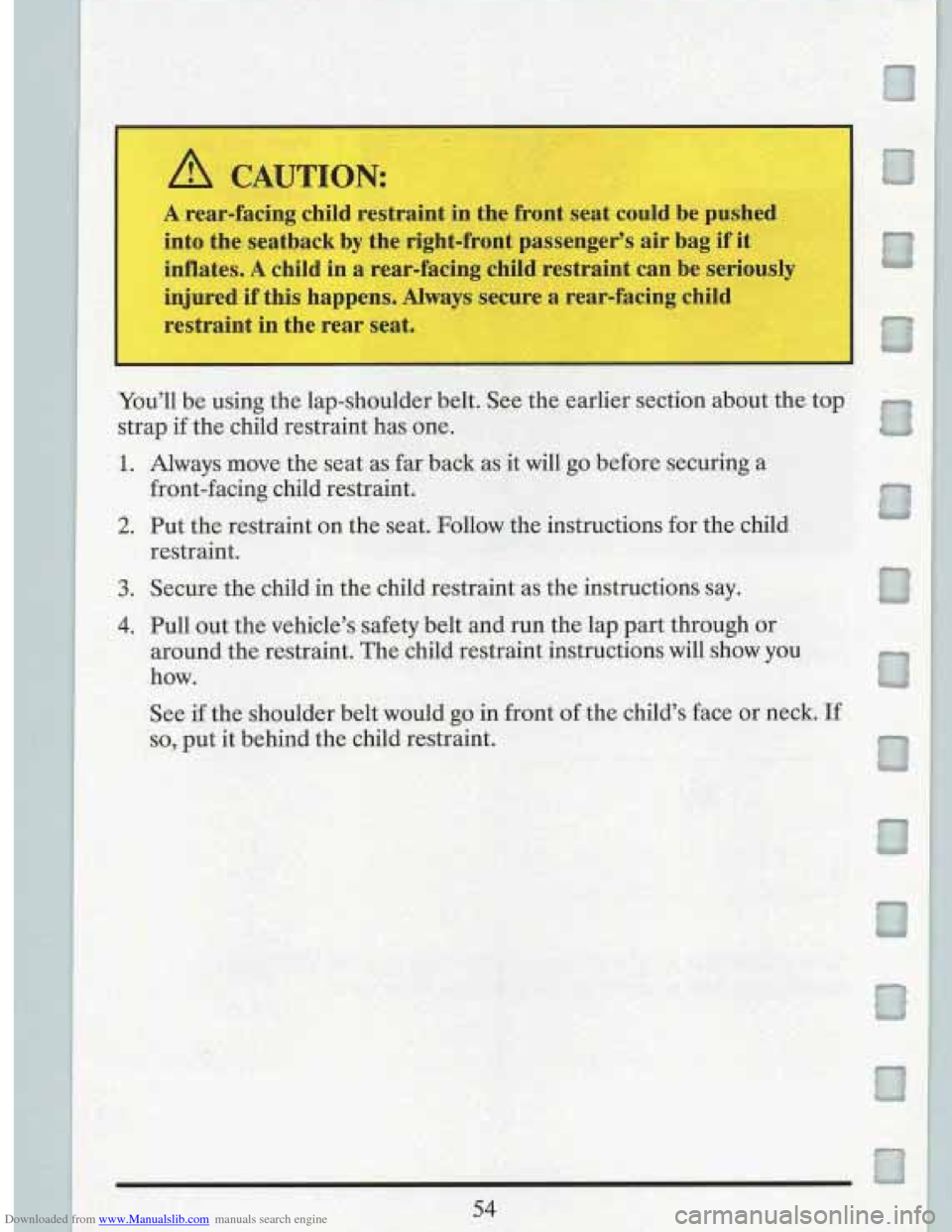
Downloaded from www.Manualslib.com manuals search engine A CAUTION:
A rear-facing child restraint in the front seat could be pushed
into the seatback by the right-front passenger's air bag if it
inflates.
A child in a rear-facing child restraint can be seriously
injured if this happens. Always secure a rear-facing child
restraint in the rear seat.
3. Secure the child in the child restraint as the instructions say.
4. Pull out the vehicle's safety belt and run the lap part through or
around the restraint. The child restraint instructions will show you
how.
See if the shoulder belt would
go in front of the child's face or neck. @
so, put it behind the child restraint.
II
Page 70 of 386
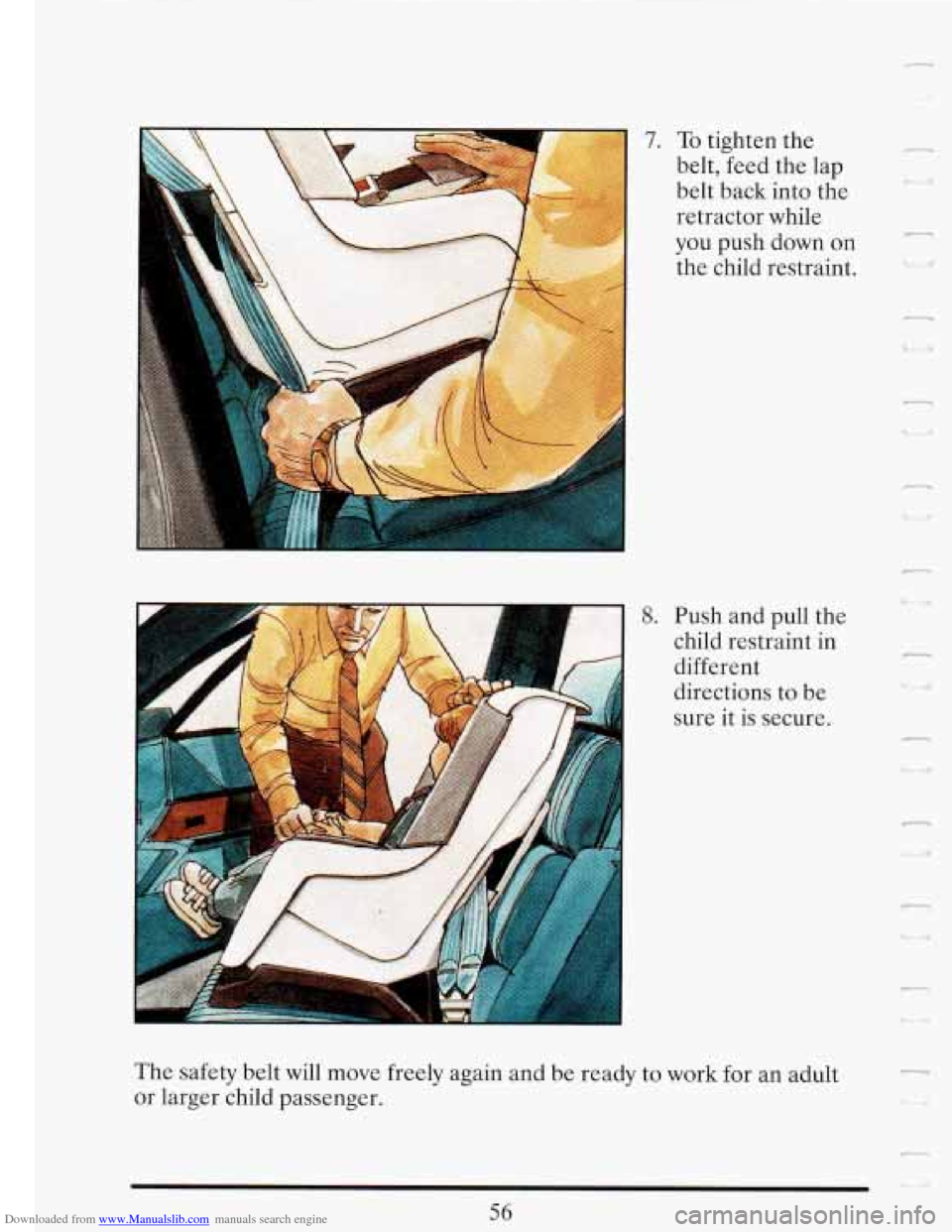
Downloaded from www.Manualslib.com manuals search engine T
. .. ..- .
7. To tighten the
belt, feed the lap
belt back into the
retractor while
Ish down
on
ild restraint.
p_
YOU P'
the ch
n
n
-
8. Push and pull the
child restraint in
different
directions to be
sure it is secure.
-
The safety belt will move freely again and be ready to work for an adult
or larger child passenger. r_
W
56
Page 89 of 386
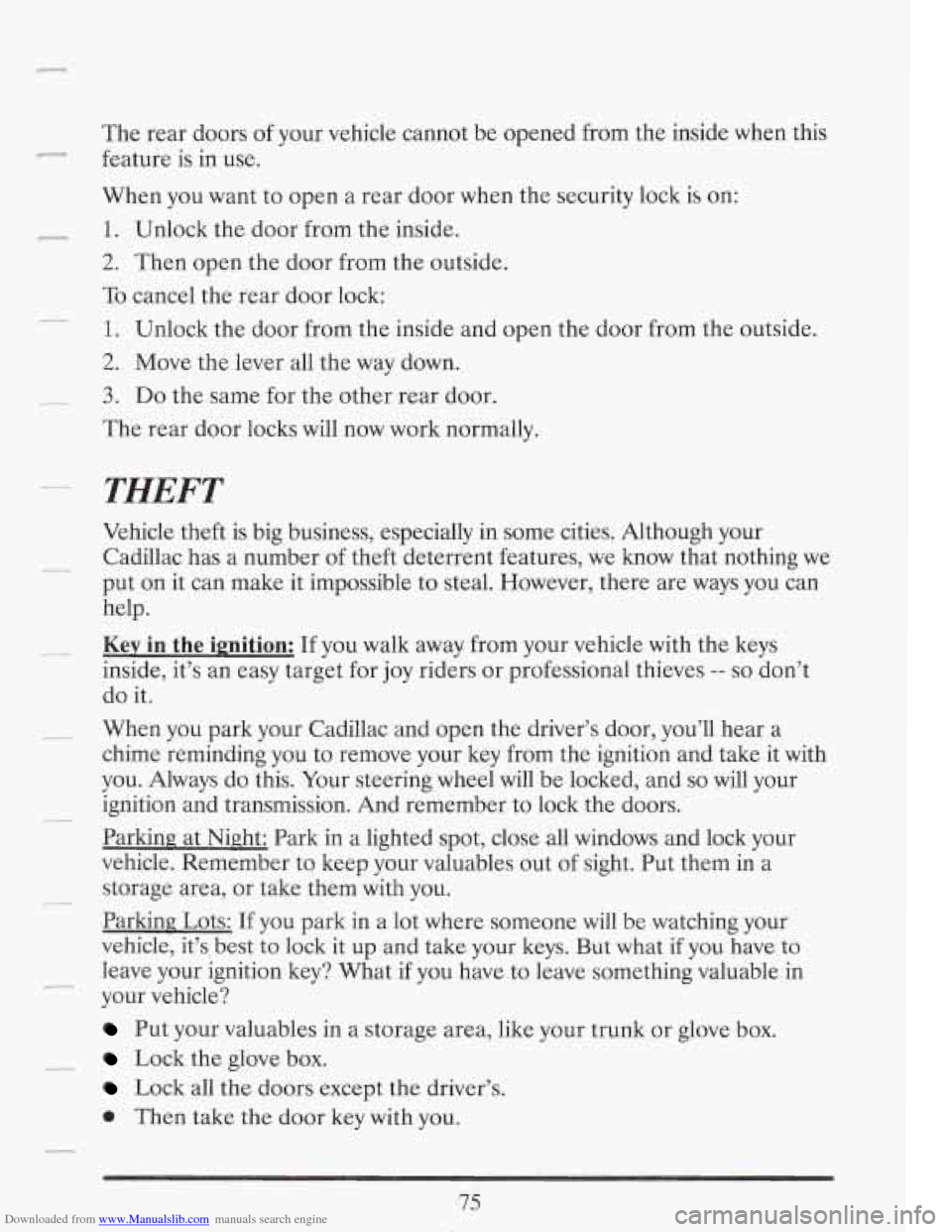
Downloaded from www.Manualslib.com manuals search engine The rear doors of your vehicle cannot be opened from the inside when this
feature is in use.
When you want to open a rear door when the security lock is on:
1. Unlock the door from the inside.
2. Then open the door from the outside.
To cancel the rear door lock:
1. Unlock the door from the inside and open the door from the outside.
2. Move the lever all the way down.
- 3. Do the same for the other rear door.
The rear door locks will now work normally.
THEFT
Vehicle theft is big business, especially in some cities. Although your
Cadillac has a number
of theft deterrent features, we know that nothing we
put on it can make it impossible to steal. However, there are ways you can
help.
Key in the ignition: If you walk away from your vehicle with the keys
inside, it’s an easy target for joy riders or professional thieves
-- so don’t
do it.
When you park your Cadillac and open the driver’s door, you’ll hear a
chime reminding you to remove your key from the ignition and take it with
you. Always do this. Your steering wheel
will be locked, and so will your
ignition and transmission. And remember to lock the doors.
Parking at Night: Park in a lighted spot, close all windows and lock your
vehicle. Remember to keep your valuables out of sight. Put them in a
storage area, or take them with you.
Parking Lots: If you park
in a lot where someone will be watching your
vehicle, it’s best to lock it
up and take your keys. But what if you have to
leave your ignition key? What if you have to leave something valuable in
your vehicle?
Put your valuables in a storage area, like your trunk or glove box.
Lock the glove box.
Lock all the doors except the driver’s.
0 Then take the door key with you.
75
Page 90 of 386

Downloaded from www.Manualslib.com manuals search engine THEFT DETERRENT (OPTION)
If your Cadillac has this
option,
it has a theft
deterrent alarm system.
With this system, the
“SECURITY
SYSTEM” light
will
flash as you open the
door
(if your ignition is
off).
Y
h . . w . ---I.
L
This light reminds you to arm the theft deterrent system. Here’s how to
do it:
1. Open the door.
2. Lock the door with the power door lock switch or Keyless Entry
System. The “SECURITY SYSTEM” light should come on and stay
on.
3. Close all doors. The “SECURITY SYSTEM” light should go off.
If a door or the trunk is opened without the key, the alarm will go off. It I
will also go off if a door lock or the trunk lock is damaged. Your vehicle’s ,
lights will flash and the horn will sound.
Remember, the theft deterrent system won’t arm
if you lock the doors r
with a key or manual door lock. It arms only if you use a power door lock A
switch or Keyless Entry System.
Here’s how
to avoid setting off the alarm by accident:
If you don’t want to arm the theft deterrent system, the vehicle should
Always unlock a door with a key or Keyless Entry System. Unlocking a
be
locked after the doors are closed.
7
door any other way will set off the alarm.
Yi
If you set off the alarm by accident, unlock any door with your key or
Keyless Entry System. - II Y
76
Page 91 of 386

Downloaded from www.Manualslib.com manuals search engine r The alarm won’t stop if you try to unlock a door any other way.
How to Test The Alarm
Roll down your window and lock your vehicle using the power door
Reach in and unlock the door using the manual lock, and open the
lock.
door. The horn will sound and your headlights will flash.
If the alarm does not sound when it should, check to see
if the horn
- works. The horn fuse may be blown. To replace the fuse, see “Fuses and
Circuit Breakers” in the Index.
To reduce the possibility of theft, always arm the theft deterrent system
- when leaving your vehicle.
PASS-KEY IIm
- Your vehicle is equipped with the PASS-Key I1 TM (Personalized
- different to arm or disarm the system. It works when you insert or remove
Automotive Security System)
theft deterrent system. PASS-Key
I1 is a
passive theft deterrent system. This means you don’t have to do anything
the
key from the ignition. PASS-Key TM uses a resistor pellet in the
ignition key that matches a decoder in your vehicle.
key, it shuts down the vehicle’s starter and fuel systems. For about three
minutes, the starter won’t work and fuel won’t go to the engine. If
__ someone tries to start your vehicle again or uses another key during this
time, the vehicle will not start. This discourages someone from randomly
trying different keys with different resistor pellets in an attempt to make
a
match.
The ignition key must be clean and dry before it’s inserted in the ignition
or the engine may not start.
If the engine does not start and and the
the ignition off.
Clean and dry the key. Wait about three minutes and try again. The
work, and the key appears to be clean and dry, wait about three minutes
and try the other ignition key. At this time, you may also want to check
- When the PASS-Key I1 TM system senses that someone is using the wrong
I_
- “PASS KEY FAULT” light comes on, the key may be dirty or wet. Turn
__ security light will remain on during this time. If the starter still won’t
77
Page 92 of 386
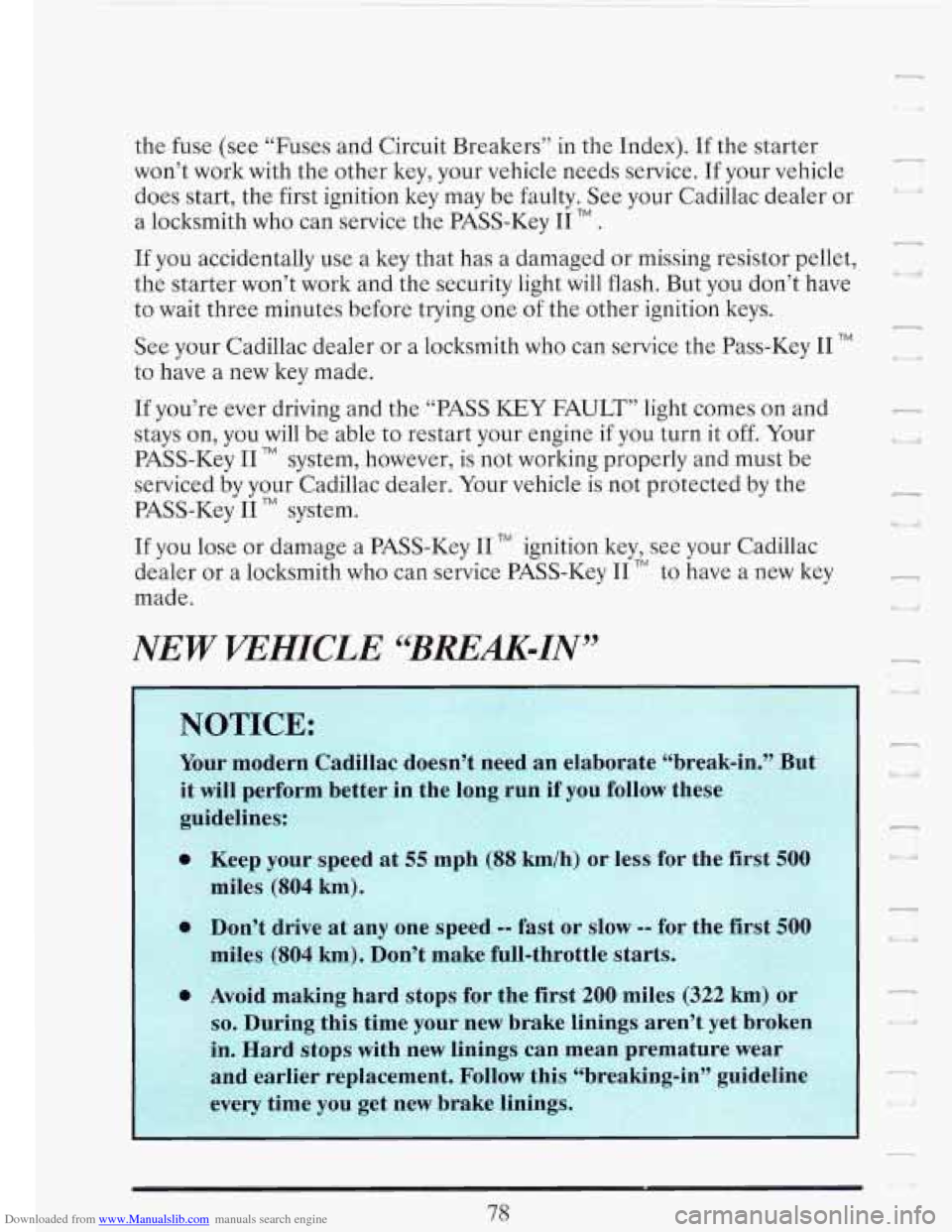
Downloaded from www.Manualslib.com manuals search engine the fuse (see “Fuses and Circuit Breakers” in the Index). If the starter
won’t work with the other key, your vehicle needs service. If your vehicle
does start, the first ignition key may be faulty. See your Cadillac dealer or
a locksmith who can service the PASS-Key I1
TM .
lis,
5
If you accidentally use a key that has a damaged or missing resistor pellet,
the starter won’t work and the security light
will flash. But you don’t have
to wait three minutes before trying one
of the other ignition keys. 7
See your Cadillac dealer or a locksmith who can service the Pass-Key I1 TM
to have a new key made.
I.
If you’re ever driving and the “PASS KEY FAULT” light comes on and
stays on, you will be able to restart your engine
if you turn it off. Your
PASS-Key
I1 TM system, however, is not working properly and must be
serviced by your Cadillac dealer. Your vehicle is not protected by the
PASS-Key
I1 TM system.
If you lose or damage a PASS-Key I1
TM ignition key, see your Cadillac
dealer or a locksmith who can service PASS-Key
I1 TM to have a new key
made.
NEW VEHICLE “BREAK=IN”
-
Y
Page 218 of 386
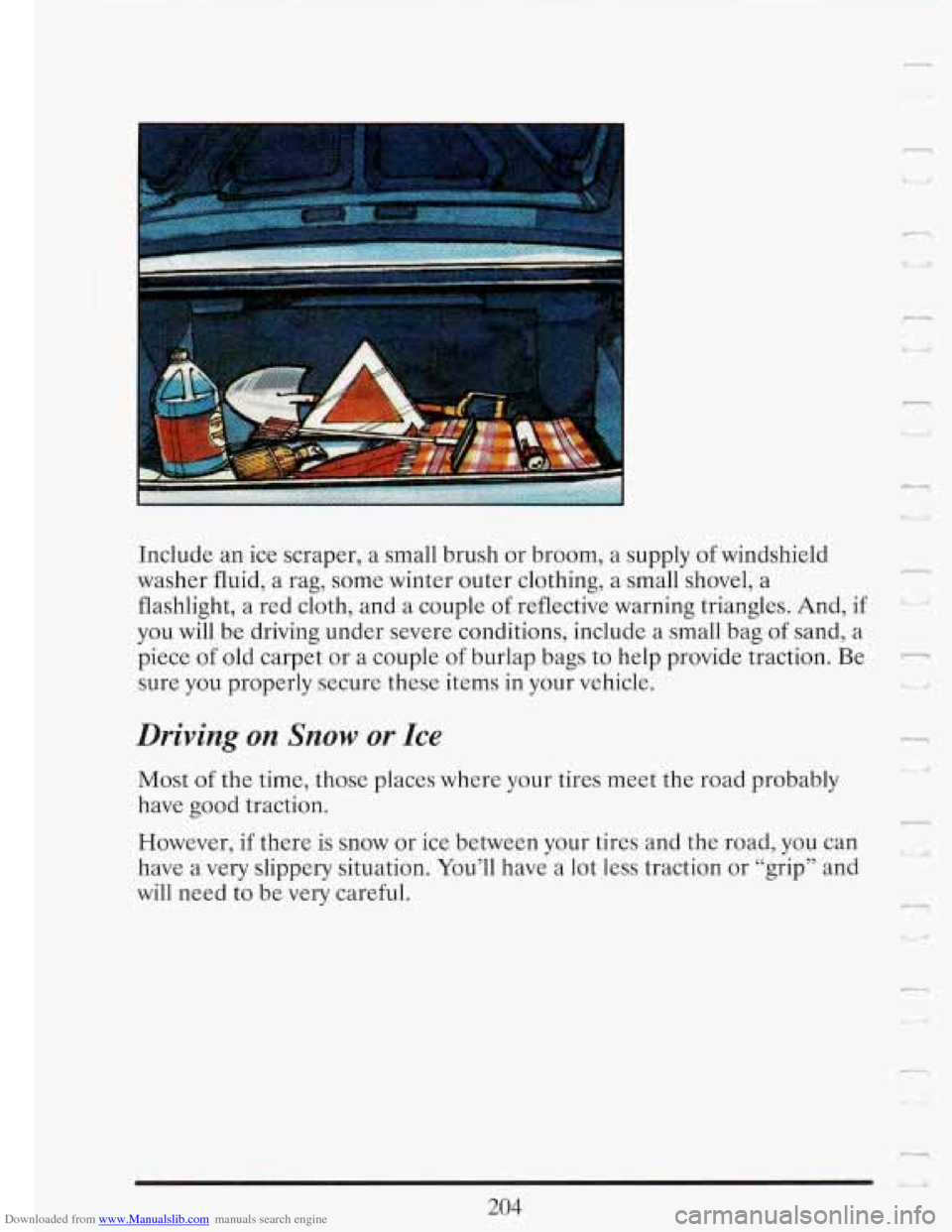
Downloaded from www.Manualslib.com manuals search engine 4
n
Include an ice scraper, a small brush or broom, a supply of windshield
washer fluid, a rag, some winter outer clothing, a small shovel, a
flashlight, a red cloth, and a couple of reflective warning triangles. And,
if ' -
you will be driving under severe conditions, include a small bag of sand, a
piece of old carpet or a couple of burlap bags to help provide traction. Be
-
sure you properly secure these items in your vehicle.
n
Driving on Snow or Ice F
Most of the time, those places where your tires meet the road probably
have good traction.
However,
if there is snow or ice between your tires and the road, you can
have a
very slippery situation. You'll have a lot less traction or "grip" and
will need
to be very careful.
c_
204
Page 226 of 386
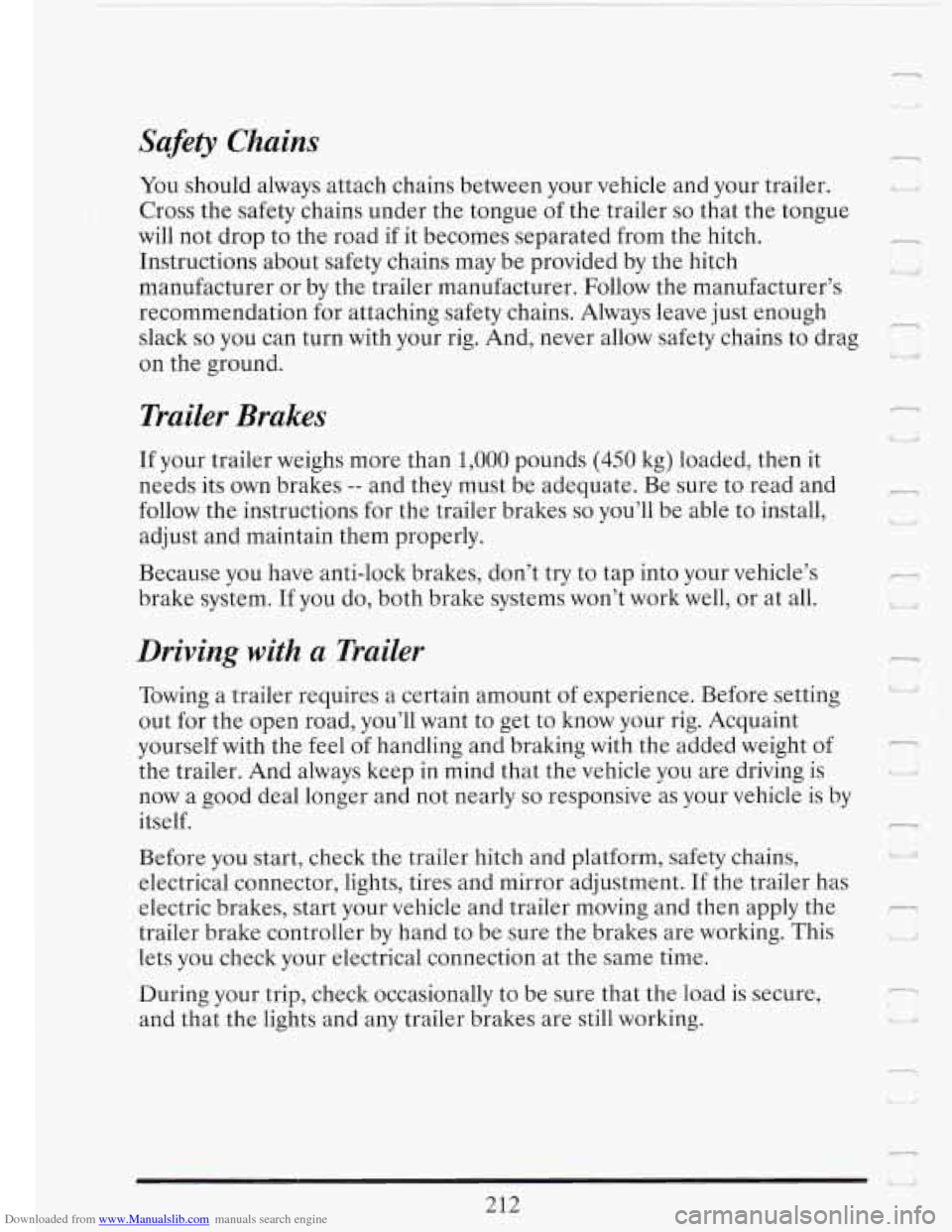
Downloaded from www.Manualslib.com manuals search engine Safety Chains
You should always attach chains between your vehicle and your trailer.
Cross the safety chains under the tongue
of the trailer so that the tongue
will not drop to the road if it becomes separated from the hitch.
Instructions about safety chains may be provided by the hitch
manufacturer or by the trailer manufacturer. Follow the manufacturer’s
recommendation for attaching safety chains. Always leave just enough
slack
so you can turn with your rig. And, never allow safety chains to drag
on the ground.
-
,-
Trailer Brakes
If your trailer weighs more than 1,000 pounds (450 kg) loaded, then it
needs its
own brakes -- and they must be adequate. Be sure to read and
follow the instructions for the trailer brakes
so you’ll be able to install,
adjust and maintain them properly.
Because
you have anti-lock brakes, don’t try to tap into your vehicle’s
brake system. If you do, both brake systems won’t work well, or at all.
Driving with a Trailer
Towing a trailer requires a certain amount of experience. Before setting
out for the open road, you’ll want to get to know your rig. Acquaint
yourself with the feel of handling and braking with the added weight of
the trailer. And always keep
in mind that the vehicle you are driving is
now a good deal longer and not nearly
so responsive as your vehicle is by
itself.
-
Before you start, check the trailer hitch and platform, safety chains, ..
electrical connector, lights, tires and mirror adjustment. If the trailer has
electric brakes, start your vehicle and trailer moving and then apply the
trailer brake controller by hand to be sure the brakes are working. This
lets you check your electrical connection at the same time.
During your trip, check occasionally to be sure that the load
is secure,
and that the lights and any trailer brakes are still working.
212